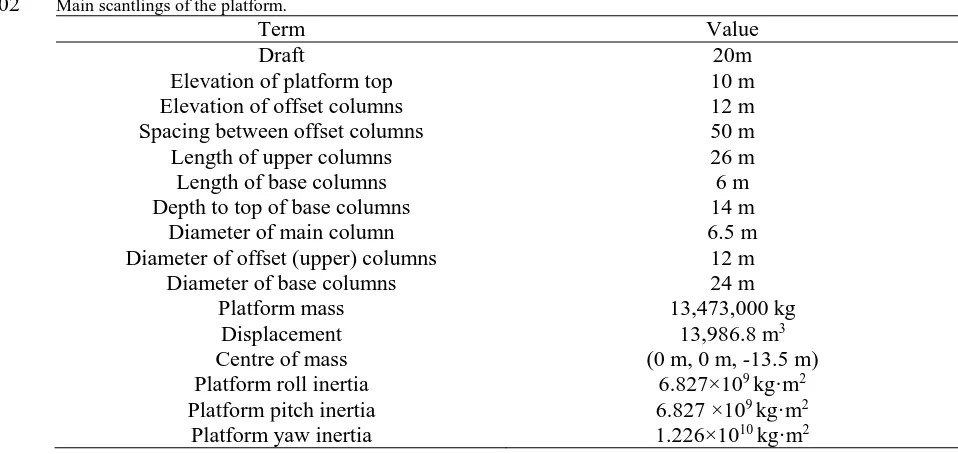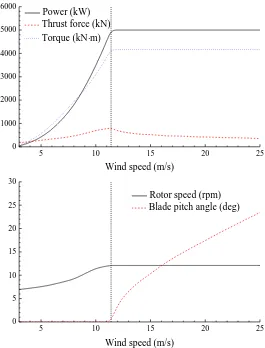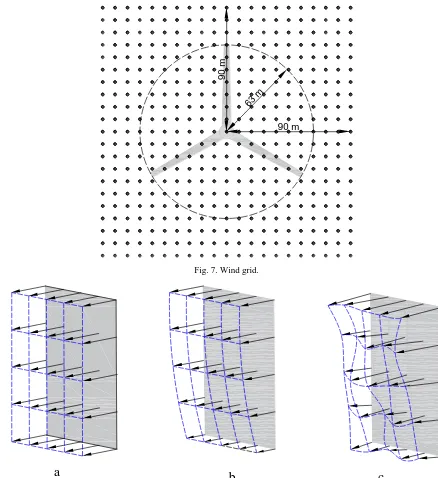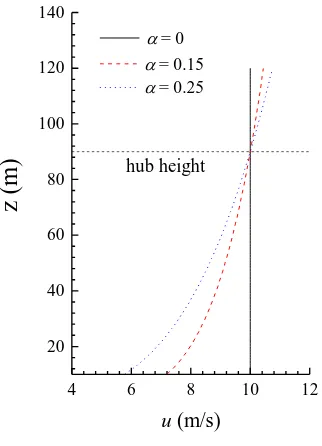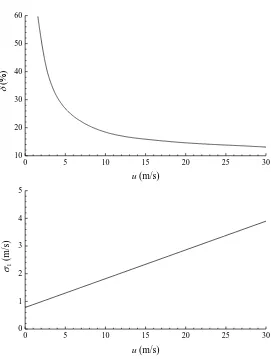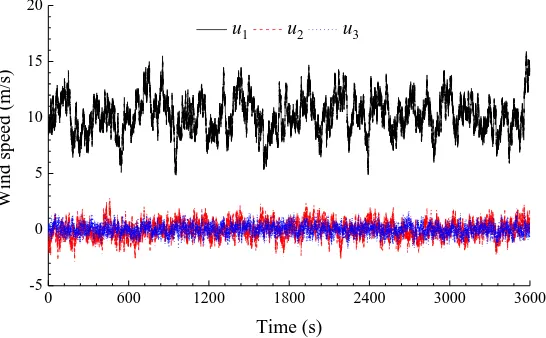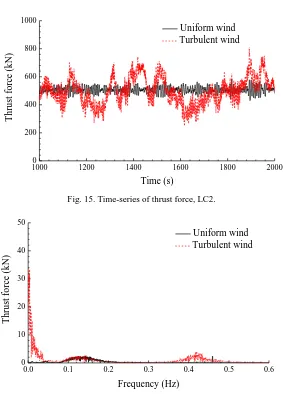Wind field effect on the power generation and aerodynamic performance of
1offshore floating wind turbines
2Liang Li, Yuanchuan Liu, Zhiming Yuan*, Yan Gao 3
Department of Naval Architecture, Ocean and Marine Engineering, University of Strathclyde, UK
4
Abstract
5This study is aimed at investigating wind field effect on the power generation and the aerodynamic 6
performance of offshore floating wind turbines. For this purpose, three comparative wind fields are 7
generated: a uniform wind field, a steady wind field with wind shear, and a turbulent wind field. Aero-8
hydro-servo coupled analysis is performed in time-domain to estimate how a referenced 9
semisubmersible offshore floating wind turbine behaves in the three wind fields. The results reveal the 10
importance of wind shear and inflow turbulence to the performance of the floating wind turbine. Thrust 11
force and power generation become very unstable in the presence of inflow turbulence. Due to the 12
control strategy of the wind turbine, the power generation is also correlated with operational state and 13
turbulence frequency. Although wind shear has a tiny effect on the rotor performance, the local 14
aerodynamic load applied at a single blade experiences fluctuation with the presence of wind shear. It 15
is also shown that the ultimate structural and fatigue damage loads at blade root are augmented by 16
inflow turbulence and wind shear. 17
Keywords: wind field; inflow turbulence; wind shear; power generation; aerodynamic performance; 18
offshore floating wind turbine 19
1.
Introduction
20
Global demand for energy is expected to climb by up to 25% [1] by 2040 and the world is pursuing 21
economic and sustainable energy sources to keep up with this considerable demand growth. In such 22
circumstance, the utilization of offshore wind energy resources is stimulated, leading to the 23
development of offshore floating wind turbine. Statoil [2] proposed a Spar-buoy floating wind turbine, 24
namely the Hywind concept, which is the first full-scale floating wind turbine that has ever been built. 25
Principle Power installed a full-scale 2MW WindFloat prototype near the coast of Portugal [3]. Most 26
recently, Hywind Scotland, the world’s first floating wind farm, already starts to deliver electricity to 27
the grid [4]. In addition to the installation of full-scale floating wind turbines, a series of model test 28
researches have been performed in the meanwhile [5-7]. The noticeable feature of offshore floating 29
wind turbines compared with traditional land-based wind turbines is that the wind turbine is mounted 30
on a floating platform displaced in the waves with mooring system. Therefore, the floating wind turbine 31
is also subject to wave loads. Besides, the dynamics of mooring lines also have an influence on the 32
response of floating wind turbines. Consequently, the study of offshore floating wind turbine is a multi-33
disciplinary coupled analysis. Liu et al. [8] developed a CFD simulation tool for the fully coupled model 34
of floating wind turbines. The aero-hydro-mooring coupled response of an integrated floating wind 35
turbine was examined in [9, 10]. 36
So far, the uniform wind field is usually assumed in the studies of floating wind turbine to simplify 37
the aerodynamic modelling [8-12]. Nevertheless, the real wind field in the natural world is far more 38
complex. Wind is by nature motion of air in the planetary boundary layer, and a stochastic process at 39
time and space scales [13] (see Fig. 1). The near-ground wind field is essentially gust or turbulent wind, 40
the modelling of which is usually based on classical assumptions on the probability density function of 41
wind speed and the shape of the wind profiles under various atmospheric stability conditions. That is to 42
say, the inflow turbulence and the wind shear are two basic features of a wind field. A couple of 43
approaches have been proposed, including the Kaimal and the Karman models, to model the inflow 44
turbulence. Most turbulence models are based on spectral method, which divides the turbulent inflow 45
into a set of turbulence components with various frequencies. In the space scale, the near-ground wind 46
field also varies with height. Popular models describing the wind profile include the power-law wind 47
profile, the low-level jet wind profile and the logarithmic wind profile. 48
[image:2.595.164.439.401.574.2]49
Fig. 1. Classification of wind. 50
Apparently, the uniform wind field is deficient to evaluate the performance of offshore floating wind 51
turbines. In fact, previous measurements on land-based wind turbines have shown that the wind field 52
has an observable influence on the aerodynamic performance. Lubitz [14] investigated the ambient 53
turbulence on the energy production of a small wind turbine. It was concluded that turbulence was 54
beneficial to the power production at low wind speeds whereas reduced the power production at high 55
wind speeds. Li et al. [15] carried out model test in wind channel to study how the power generation of 56
a horizontal axis wind turbine reacted to the turbulent inflow. According to their measurement, the 57
optimum power coefficient was dependent on the turbulence intensity. Chamorro et al. [16] launched 58
an experiment to study the unsteady behaviour of a full-scale 2.5 MW wind turbine in turbulent inflow. 59
trade winds westerlies polar winds fronts
huricanes cyclones thunderstorms
moutain winds tornadoes 10000 km
1000 km 100 km 10 km
1 km 100 m 10 m 1 m
years year
month week day hour minute
Sp
ace
scal
e
Time scale second
gust
Their measurement also revealed a correlation between the turbulence intensity and the power 60
production. Similar relationship was observed by Lee et al. [17] in the field measurement of a small 61
vertical-axis wind turbine installed on the rooftop of a building. In addition to the inflow turbulence, 62
the realistic wind field also varies in vertical direction so that the wind shear effect should be considered 63
as well. Shen et al. [18] used the lifting surface method to simulate the unsteady and periodic blade root 64
loads and wind turbine performance in the presence of wind shear. Sezer-Uzol and Uzol [19] showed 65
that the existence of wind shear can create a very complex wake structure with substantial asymmetries, 66
streamwise vorticity generation, and non-periodicities downstream of the turbine rotor. Dolan and Lehn 67
[20] developed an analytical formulation for the torque of a three-bladed wind turbine with 68
consideration of the wind shear. They showed that the torque and the thrust force were only very slightly 69
influenced by the wind shear, but the local aerodynamic loads on a single blade were sensitive to the 70
wind shear. Similar phenomenon was observed by Li et al. [21]. 71
Although the effects of inflow turbulence and wind shear on the aerodynamic performance of wind 72
turbines have been manifested in previous studies, they were examined with a bottom-fixed wind 73
turbine, and no wind turbine active control was considered. In real practice, the floating platform 74
undertakes motions under joint aerodynamic and hydrodynamic excitations. Also, an offshore floating 75
wind turbine always incorporates a controller to regulate its power generation subject to various wind 76
speeds. For a floating wind turbine, the wind field effect may show new characteristics due to the aero-77
hydro-servo couplings. This study is aimed at investigating the effect of wind field on the performance 78
of offshore floating wind turbines, in terms of power generation, thrust force and blade root bending 79
moment. Aero-hydro-servo coupled analysis is conducted in time-domain to capture the performance 80
of a semisubmersible floating wind turbine in three categories of wind fields, namely a uniform wind 81
field, a steady wind field with consideration of wind shear and a turbulent wind field. The discussions 82
will be highlighted on how the performance of the floating wind turbine reacts to the wind shear and 83
the inflow turbulence. 84
2.
Model Description
85
As shown in Fig. 2, the OC4 DeepCwind semisubmersible concept [22] is considered in this work. 86
The wind turbine is the NREL 5 MW baseline wind turbine [23], which incorporates a variable-speed 87
torque controller and a blade pitch controller to regulate the power generation based on the operational 88
state. In below-rated state, the control strategy is to maximize the power generation by adjusting the 89
rotor speed. In over-rated state, the controller regulates the power generation by increasing the blade 90
92
Fig. 2. DeepCwind floating wind turbine system design [24]. 93
A three-column submersible platform is used to carry the wind turbine (see Fig. 3). The platform is 94
made up of three main offset columns inducing buoyance and restoring force, one central column 95
supporting the wind turbine, as well as a series of diagonal cross and horizontal bracing components. 96
To gain a good hydrostatic stability performance, a ballast tank is installed at the bottom of each main 97
offset column. The main scantlings of the platform are listed in Table 1. 98
99
[image:4.595.135.457.530.705.2]Table 1 101
Main scantlings of the platform. 102
Term Value
Draft 20m
Elevation of platform top 10 m
Elevation of offset columns 12 m
Spacing between offset columns 50 m
Length of upper columns 26 m
Length of base columns 6 m
Depth to top of base columns 14 m
Diameter of main column 6.5 m
Diameter of offset (upper) columns 12 m
Diameter of base columns 24 m
Platform mass 13,473,000 kg
Displacement 13,986.8 m3
Centre of mass (0 m, 0 m, -13.5 m)
Platform roll inertia 6.827×109 kg·m2
Platform pitch inertia 6.827 ×109 kg·m2
Platform yaw inertia 1.226×1010 kg·m2
103
The floating wind turbine is displaced at sea site with a water depth of 200m. The mooring system 104
is composed of three catenary lines. The three mooring lines are oriented symmetrically at 60°, 180°, 105
and 300° about the vertical axis. Fairleads are connected to the tops of ballast tanks. The relevant 106
[image:5.595.44.523.85.312.2]properties of mooring lines are outlined in Table 2. 107
Table 2 108
Properties of mooring line. 109
Term Value
Depth to anchor 200 m
Depth to fairlead 14 m
Radius to anchor 853.7 m
Radius to fairlead 40.868 m
Unstretched mooring line length 835.5 m
Mooring line diameter 0.0766 m
Equivalent line mass density 113.35 kg/m
Equivalent mooring line extensional stiffness 753.6 MN 110
3.
Methodology
111
The aero-hydro-servo coupled simulation code FAST [25] developed by the National Renewable 112
Energy Laboratory (NREL) is used to simulate the dynamic performance of the DeepCwind floating 113
wind turbine in various wind fields. 114
3.1.
Hydrodynamic modelling
115
The wave kinetics are addressed within the framework of potential flow theory, assuming that the 116
fluid is inviscous, incompressible and irrotational. Three components of hydrodynamic loads are 117
accounted: hydrostatic force, radiation wave force (including memory effect of the free water surface), 118
sufficiently long, second-order drift wave forces are also considered to capture the low-frequency 120
responses of the floating wind turbine. The hydrodynamic coefficients (added mass, potential damping, 121
wave force transfer function) are firstly calculated in frequency domain. By applying the Inverse FFT 122
(fast Fourier transform), the frequency-dependent coefficients are transformed to time-domain to 123
complete the simulations. 124
3.2.
Aerodynamic modelling
125
126
Fig. 4. Local inflow velocity at blade element. 127
Aerodynamic calculations are based on the blade element momentum (BEM) method, where the 128
blade is divided into a set of elements, and the elements are assumed independent from each other. The 129
distributed pressure and shear stress at each element are approximated by lift force and drag force. As 130
shown in Fig. 4, the BEM method calculates aerodynamic loads by evaluating the relative inflow speed 131
seen the by the blade element 132
2 21 (1 ')
1 tan
1 '
rel
r
u u a a
u
u a
r a
(1) 133
where r is the radius of the blade element and Ω is the rotor speed. β is the blade pitch angle. a and a’
134
are the so-called axial and rotational induction factors, which are functions of attack angle θ and 135
aerodynamic coefficients of the blade. In practice, an initial condition of a and a’ is set, and the relative
136
speed is obtained. Afterwards, update a and a’ with the obtained relative speed. Iterate the process until
137
a and a’ converge, and the local aerodynamic loads are estimated by
138
2 2
2
1 (1 )
cos sin
2 sin
1 (1 ) (1 ')
sin cos
2 sin cos
l d
l d
u a
dT c C C dr
u a r a
dM c C C rdr
(2) 139
where ρ is the air density; c is the chord length; Cl and Cd are the lift coefficient and drag coefficient,
140
The iteration indicates that the relative velocity determined by the BEM method reacts 142
instantaneously to the change of incident inflow. In fact, the BEM method is a quasi-steady approach 143
and thereby it is usually applied in the steady problem, where the incident inflow is constant. For an 144
offshore floating wind turbine, both the platform motions and the wind turbulence produce unsteadiness 145
of the inflow seen by the rotor. The hysteresis effect caused by the unsteady inflow is accounted by the 146
extended Beddoes-Leishman (B-L) model developed by Minnema [26], which can be regarded as a 147
correction to the induced velocity determined by the BEM method. 148
3.3.
Wind turbine control
149
A variable-speed torque controller and a blade pitch controller are incorporated to the wind turbine. 150
The two control systems are designed to work independently, for the most part, in the below-rated
151
and above-rated wind-speed range, respectively. The goal of the variable-speed torque controller is to 152
maximize the power capture below the rated operation point. The goal of the blade-pitch controller is 153
to regulate the generator power above the rated operation point. Fig. 5 illustrates the steady aerodynamic 154
performance of the NREL 5 MW baseline wind turbine under the regulation of the two controllers. 155
When the wind speed is lower than the rated value (11.4 m/s), the variable-speed torque controller is 156
active to tune rotor speed while the blade pitch is fixed at 0 deg to extract as much wind power as 157
possible. Within this range, the aerodynamic performance is quite sensitive to the wind speed, and the 158
power, the thrust force as well as the torque increase considerably with the wind speed. In over-rated 159
state, the blade pitch controller is active, and the rotor speed is fixed at 12.1 rpm. The blade is pitched 160
to feather to regulate the power generation. Meanwhile, the thrust force reduces as a result of the 161
163
Fig. 5. Steady aerodynamic performance of the wind turbine. 164
3.4.
Mooring system modelling
165
The lumped-mass model is used for the dynamics of mooring lines connected to the floating platform. 166
As shown in Fig. 6, the mooring line is divided into a set of evenly-sized segments, which are 167
represented by connected nodes and spring-damper systems. Each segment is divided into two 168
components and the properties are assigned and lumped to the two nodes at each end of that segment, 169
respectively. The connections between adjacent nodes are represented by damper-spring systems. Only 170
the axial properties of the mooring lines are accounted whereas the torsional and bending properties are 171
neglected. 172
173
Fig. 6. Lumped-mass model of mooring line. 174
5 10 15 20 25
0 1000 2000 3000 4000 5000 6000
Wind speed (m/s) Power (kW)
Thrust force (kN) Torque (kNm)
5 10 15 20 25
0 5 10 15 20 25 30
Wind speed (m/s)
Rotor speed (rpm) Blade pitch angle (deg)
Node 1
Node 2
Node 3
Segment 1
[image:8.595.161.435.621.715.2]4.
Environmental conditions
175In the natural world, the sea waves and offshore wind are always correlated. The joint wind-wave 176
model for the Statfjord site in the northern North Sea is used in this work [27]. Firstly, the mean wind 177
speed u at hub height (90 m above the mean sea level) is chosen. Subsequently, the fitting curve 178
provided in [27] is used to acquire the mean significant wave height Hs corresponding to a given mean
179
wind speed. Finally, the mean peak period Tp at given u and Hs is determined by Eq. (3). The
180
environmental conditions considered are listed in Table 3. The wind and waves propagate along positive 181
surge direction in all simulation cases. 182
0.78 0.529
0.78
(1.764 3.426 )
(4.883 2.68 ) 1 0.19
1.764 3.426 s
p s
s
u H
T H
H
(3)
183
Table 3 184
Joint wind and waves conditions 185
u (m/s) Hs(m) Tp(s)
LC1 5.09 2.1 9.74
LC2 8.14 2.55 9.86
LC3 10.17 2.88 9.98
LC4 14.24 3.62 10.29
LC5 18.31 4.44 10.66
LC6 22.37 5.32 11.06
186
Given that the rotor diameter is 126 m, a wind grid with dimension 180 m × 180 m is generated (see 187
Fig. 7). Such configuration guarantees that the wind grid will cover the rotor all the time. 441 points 188
(21 × 21) are uniformly distributed across the area, at which the time-series of wind speed are generated. 189
As shown in Fig. 8, three comparative wind fields are generated for each load case, and the mean wind 190
192
Fig. 7. Wind grid. 193
194
Fig. 8. Three wind fields. (a) uniform wind field; (b) steady wind field with wind shear; (c) turbulent wind field. 195
The first wind field is uniform. The wind speed vector is constant, independent on spatial position 196
and time. It is the wind field that used in most studies of offshore floating wind turbine. 197
The second one is a steady wind field with consideration of wind shear, where the wind speed varies 198
only with height. The power-law model is used to represent the wind profile, 199
( )
90
z u z u
(4)
200
where α is the exponent parameter. Fig. 9 shows the wind profiles with different values of α. The wind 201
shear becomes more significant when α increases. When α is equal to 0, the wind shear is omitted, and 202
the wind field reduces to the uniform one. In our study, α = 0.25 is used. 203
90 m
63 m
90 m
204
Fig. 9. Wind profile. 205
The first two wind fields are time-independent and the direction of inflow is always along X axis. In 206
the natural world, the wind speed not only varies in space scale but also depends on the time. Therefore, 207
a turbulent wind model should be adopted to describe this feature. The IEC Kaimal turbulent model [28] 208
is used to represent the turbulence in time scale. The time-series of wind speed are generated based on 209
the spectral method 210
2
5/3
4 /
( )
1 6 /
k k
k
k
L u S f
fL u
(5)
211
where f is the cyclic frequency; k indicates the direction (longitudinal 1, lateral 2, vertical 3); Lk is
212
defined by Eq. (6) 213
8.10 1
2.70 2
0.66 3
k
k
L k
k
(6) 214
where Λ is the turbulence scale parameter 215
0.7 min(60, hub height)
(7)
216
σk is the standard deviation, which is defined by the turbulence intensity δ
217
1
2 1
3 1
100 0.8
0.5
u
(8) 218
According to above equations, the spectrum of turbulent wind is totally dependent on the turbulence 219
intensity δ and the mean wind speed u. In the natural world, the turbulence intensity is correlated with 220
the mean wind speed, and the IEC category B turbulence model is used to determine the turbulence 221
intensity with respect to a given u. Fig. 10 shows the turbulence intensity and the corresponding standard 222
4 6 8 10 12
20 40 60 80 100 120 140
z (
m)
u (m/s)
= 0
= 0.15 = 0.25
deviation of longitudinal speed component at various mean wind speed. Although turbulent wind field 223
with high mean speed is has a small turbulence intensity, the standard deviation of wind speed is higher. 224
[image:12.595.159.430.103.462.2]225
Fig. 10. Turbulence intensity and standard deviation of longitudinal wind speed as functions of mean wind speed. 226
Fig. 11 displays the spectrum of turbulent wind and Fig. 12 plots the corresponding time-series of 227
wind speed. As shown, slow-varying component dominates the turbulent wind. Not only the amplitude 228
of the wind speed varies, but also the speed direction is time-dependent. 229
[image:12.595.159.429.550.720.2]230
Fig. 11. Spectrum of IEC Kaimal turbulent wind, u = 10.17 m/s. 231
0 5 10 15 20 25 30
10 20 30 40 50 60
u (m/s)
0 5 10 15 20 25 30
0 1 2 3 4 5
1
(
m/s)
u (m/s)
0.0 0.1 0.2 0.3 0.4 0.5
0 20 40 60 80
S
(
(m
/s)
2 /H
z
2 )
f (Hz)
232
Fig. 12. Time-series of wind speed at height hub, u = 10.17 m/s. 233
Apart from the variation in time scale, the velocity of turbulent wind field is not uniformly 234
distributed across the rotor plane in a time instant, leading to the space scale turbulence. A spatial 235
coherence model is introduced to represent the phase difference of wind velocity at different spatial 236
points 237
, ,
2 2
,
( ) ( )
( ) ( )
( ) exp 12 0.12
min 60, hub height i j i j
i j
i j
c
c
S f Coh f
S f S f
fr r
Coh f
u L
L
(9) 238
where Si,j is the cross spectrum defining the correlation of the random wind speed at points i and j, r is
239
the distance between the two points. 240
5.
Results
241
The effects of wind shear and inflow turbulence on the performance of the DeepCwind floating wind 242
turbine will be investigated in this section, in terms of thrust force, power generation and blade root 243
bending moment. For all load cases, the simulation runs 4000 s and only the last 3600 s data are 244
collected to get rid of the transient effect arising in initial simulation stage. The time step is set to 0.0125 245
s. 246
5.1.
Thrust force
247
Fig. 13 illustrates the effect of wind shear on the rotor thrust force. It shows that the wind shear 248
effect is limited, which is consistent with previous studies [20, 21]. When a blade is experiencing the 249
high wind velocity region (up half of the rotor plane), the other two blades are within low wind velocity 250
region (down half of the rotor plane). Therefore, the resultant thrust force induced by the three blades 251
0 600 1200 1800 2400 3000 3600
-5 0 5 10 15 20
Wind
sp
eed (
m/s)
Time (s)
[image:13.595.202.423.350.452.2]remains relatively stable. Of course, the aerodynamic load acting on each individual blade experiences 252
variation due to the wind shear, and this will be discussed in the following part of this paper. 253
[image:14.595.65.519.115.261.2]254
Fig. 13. Thrust force with various wind shear. 255
The statistics of thrust force in the turbulent wind field are showed in Fig. 14. Similarly, the average 256
thrust force is just slightly varied by the turbulence. Although the inflow is turbulent, the mean wind 257
speed is identical to that of the uniform wind field. Therefore, the mean thrust force acting on the rotor 258
is nearly the same. Nevertheless, the standard deviation is augmented significantly due to the inflow 259
turbulence. Fig. 15 gives an example of the thrust force time history, where it can be seen that the thrust 260
force becomes very unstable in the presence of turbulence. Fig. 16 shows the FFT analysis result of 261
thrust force. Observable low-frequency response component is excited in the turbulent wind field. As 262
shown in Fig. 11, the turbulent wind is characterized by svarying component, and thereby the low-263
frequency component is mainly induced by the very slow variation of wind speed in time scale. 264
Additionally, the blades experience inflow velocity fluctuation during the rotation due to the space scale 265
turbulence, and thereby the thrust force is also excited at the 3P rotor frequency. The high-frequency 266
responses of wind turbines are relatively difficult to monitor, and various approaches have been 267
proposed. For example, Lind et al. [29] developed a normal behaviour model to monitor high-frequency 268
wind turbine vibrations. The excitation of high-frequency thrust force highlights the importance of wind 269
turbulence to the design of wind turbines. 270
271
Fig. 14. Thrust force with various turbulence intensity. 272
LC1 LC2 LC3 LC4 LC5 LC6
0 200 400 600 800 1000
Mean (kN)
Uniform wind Wind shear
LC1 LC2 LC3 LC4 LC5 LC6
0 20 40 60 80
Std
.dev (kN
)
Uniform wind Wind shear
LC1 LC2 LC3 LC4 LC5 LC6
0 200 400 600 800 1000
Mean (kN)
Uniform wind Turbulent wind
LC1 LC2 LC3 LC4 LC5 LC6
0 30 60 90 120 150
Std
.dev (kN
)
[image:14.595.68.521.563.701.2]273
Fig. 15. Time-series of thrust force, LC2. 274
275
Fig. 16. FFT analysis result of thrust force, LC2. 276
The inflow turbulence influences not only the thrust force, but also the platform motions. 277
Considering that the surge natural period of the platform is sufficiently long (over 100 s [30]) and 278
covered by the dominating frequency range of the wind spectrum, resonant surge motion may be excited. 279
Fig. 17 represents the FFT analysis result of platform surge motion, where two response peaks are 280
observed. The first peak is located around 0.9 Hz, close to the wave energy frequency. This part of 281
motion is usually named as wave energy response, which is induced by first-order linear wave 282
excitations. Additionally, response is also observed around the natural period of surge motion, implying 283
that the resonant surge motion is excited by the second-order nonlinear wave drift forces. Due to the 284
slow-varying wind speed, the low frequency surge motion is amplified considerably by the inflow 285
turbulence. Nevertheless, the 3P rotor frequency response is not observed. It is mainly because the 3P 286
frequency is far from the resonant frequency of the platform so that the motions are not sensitive to the 287
space scale turbulence. 288
10000 1200 1400 1600 1800 2000
200 400 600 800 1000
Th
ru
st
f
o
rce (
k
N
)
Time (s)
Uniform wind Turbulent wind
0.0 0.1 0.2 0.3 0.4 0.5 0.6
0 10 20 30 40 50
Th
ru
st
f
o
rce (
k
N
)
Frequency (Hz)
[image:15.595.163.437.77.247.2]289
Fig. 17. FFT analysis result of platform surge motion, LC2. 290
5.2.
Power generation
291
Fig. 18 represents the statistics of wind turbine power generation with respect to the three wind fields. 292
In general, the average power generation is merely dependent on the mean wind speed whereas varies 293
little with wind shear and inflow turbulence. The wind shear has a small influence on the fluctuation of 294
power generation. Nevertheless, the standard deviation increases significantly once the floating wind 295
turbine is subject to the turbulent inflow. According to Fig. 10, the standard deviation of wind speed 296
variation increases with the mean wind speed, so that the fluctuation of the power generation should 297
also be more noticeable. Such deduction is consistent with the variation trend in below-rated operational 298
state (LC1-LC3). Nevertheless, the fluctuation of power is reduced in over-rated operational sate (LC4-299
LC6), even if the wind field becomes more turbulent. It is attributed to the two controllers, which are 300
active in different operational states. In the below-rated state, the variable-speed torque controller is 301
active to maximise the power generation so that the power generation is very sensitive to the wind speed 302
(see Fig. 5). In this case, the power generation reacts promptly to the variation of wind speed and thereby 303
the standard deviation is augmented. Comparatively, it is the blade pitch controller that regulates the 304
wind turbine in the over-rated operational state, which aims to keep the power generation at the rated 305
value 5 MW. Consequently, the wind power remains relatively robust to the variation of wind speed. 306
Since the blade pitch controller is not perfect and takes time to react to the inflow, the fluctuation of 307
power generation is not omitted completely. 308
0.00 0.05 0.10 0.15 0.20 0.25 0.30
0.0 0.1 0.2 0.3 0.4 0.5 0.6
Su
rg
e (
m)
Frequency (Hz)
309
Fig. 18. Statistics of wind turbine power generation. 310
To figure out the dynamic feature of power generation, Fig. 19 demonstrates the FFT analysis result 311
of power generation when the wind turbine is operating in below-rated state, where three regions are 312
identified. This first region is located on the high frequency range where little response is observed. It 313
is mainly because the turbulent wind is slow-varying, and the turbulence spectrum carries little energy 314
around high frequency range (see Fig. 11). The power generation is most sensitive to the inflow 315
turbulence in the intermediate range of frequencies. Within this region, the power generation increases 316
rapidly as the varying frequency of the turbulent inflow reduces. The last region is the very low 317
frequency range. In the very low frequency range, the power generation is not sensitive to the variation 318
frequency of the turbulence. Similar phenomenon was observed in the field measurement of a full-scale 319
2.5 MW land-based wind turbine [16]. 320
[image:17.595.163.435.435.604.2]321
Fig. 19. FFT analysis result of power generation in turbulent wind, LC2. 322
Fig. 20 shows the spectral property of the power generation in over-rated operation state. Despite 323
that three regions are identified, Fig. 20 shows a noticeable discrepancy compared with Fig. 19: the 324
power generation reacts little to the very low frequency turbulence component. It indicates that the 325
slow-varying turbulence is unable to stimulate strong fluctuation of power generation in the over-rated 326
operational state. 327
LC1 LC2 LC3 LC4 LC5 LC6
0 1000 2000 3000 4000 5000 6000
Mean (kW)
Uniform wind Wind shear Turbulent wind
LC1 LC2 LC3 LC4 LC5 LC6
0 300 600 900 1200
Std
.dev (kW)
Uniform wind Wind shear Turbulent wind
10-4 10-3 10-2 10-1 100
0 30 60 90 120 150 180
III II
Po
w
er
g
ener
at
io
n
(
k
W)
Frequency (Hz)
328
Fig. 20. FFT analysis result of power generation in turbulent wind, LC5. 329
According to Fig. 19 and Fig. 20, one can see that the power generation reacts to the very low 330
frequency turbulence in different ways depending on the operational state. To interpret the mechanism 331
behind, we run an extra simulation to examine the reaction of power generation to inflow with various 332
oscillation frequencies, where the wind turbine is bottom-fixed and the wind shear is omitted. The time-333
varying inflow speed is defined as 334
0
( ) sin(2 )
( ) 2 cos(2 )
u t u u ft
du t f u ft
(10)
335
where u0 is the mean wind speed and ∆u is the speed fluctuation. Two frequencies f are selected from 336
the second and the third regions, namely f = 0.01 Hz and f = 0.001 Hz. Also, u0 = 8.14 m/s and u0 = 337
18.31 m/s are selected to represent below-rated and over-rated operational states, respectively. ∆u is set 338
to 2 m/s in all cases. 339
Fig. 21 illustrates how the wind turbine responds to the inflow turbulence at below-rated and over-340
rated states, respectively. In the over-rated state, the power generation is nearly constant in the presence 341
of very slow-varying inflow whereas the power fluctuation is noticeable when the frequency is 342
sufficiently high. According to Eq. (10), the speed increment du of very low frequency turbulence 343
component is very small. The blade pitch controller is able to compensate the tiny external disturbance 344
and regulates the power generation. Consequently, the power generation reacts little to the very low 345
frequency turbulence component and keeps at the rated value 5MW. When f increases, the speed 346
increment is augmented accordingly. The pitch controller can’t afford to compensate the amplified 347
disturbance, and unstable power generation occurs. It explains why the power production is robust to 348
the very low frequency turbulence whereas sensitive to the moderate low frequency turbulence in Fig. 349
20. In the below-rated, nevertheless, the control objective is to maximize the power so that any tiny 350
variation of inflow speed will change the power generation, regardless of the wind speed varying 351
frequency (see Fig. 21(b)). In summary, the effect of inflow turbulence on the power generation is 352
dependent on the operational state due to the control scheme of the wind turbine. 353
10-4 10-3 10-2 10-1 100
0 20 40 60
III II I
Po
w
er
g
ener
at
io
n
(
k
W)
354
Fig. 21. Reaction of power generation of sinusoidal inflow. (a) over-rated state, u0 = 18.31 m/s. (b) below-rated state, u0 = 355
8.14 m/s. 356
5.3.
Blade root bending moment
357
The generator of a wind turbine is driven by the blade, and blade root is the connection point of 358
blade and generator shaft. Therefore, blade root is a critical structure point, in terms of ultimate load 359
and fatigue damage. 360
The ultimate blade root bending moment is estimated based on the mean up-crossing rate method. 361
The distribution of extreme value Mmax is assumed to follow 362
max 0 0
0
( ) exp ( , )
T
P M M v M t dt
(11)363
where 𝑣+(𝑀0, 𝑡) is the up-crossing rate corresponding to level 𝑀0, which denotes the instantaneous 364
frequency of the positive slop crossings of the defined level. The mean up-crossing rate is given by 365
0 0
0 1
( ) ( , )
T
v M v M t dt T
(12)366
S-N method is used to evaluate the corresponding fatigue damage load. It is assumed that the damage 367
accumulates linearly with each of hysteresis cycles according to Miner’s Rule. In this case, the overall 368
damage load (DL) produced by all the cycles is given by 369
200 400 600 800 1000
2000 3000 4000 5000 6000 7000 8000
Po
w
er
g
ener
at
io
n
(
k
W)
Time (s)
f = 0.001 Hz
f = 0.01 Hz
200 400 600 800 1000
0 1000 2000 3000 4000 5000 6000
Po
w
er
g
ener
at
io
n
(
k
W)
Time (s)
f = 0.001 Hz
f = 0.01 Hz
a
1m m i i STeq
n L DL
n
(13)
370
where nSTeq =feq∙T is the total equivalent fatigue counts, feq (1 Hz in this paper) is the fatigue load
371
frequency and T is the simulation time. ni is the cycle count and Li is the cycle's load range about a fixed
372
load-mean. m is the Wholer exponent. Considering the geometry of the tower and the blade, the B1 373
category of S-N curve suggested by [31] is selected and m is set to 4. It worth noting that other 374
alternative approaches are available to estimate the fatigue loads. For example, Lind et al. [32] proposed 375
[image:20.595.38.531.102.529.2]a procedure to estimate the fatigue loads on wind turbines, based on stochastic differential equations. 376
Fig. 22 displays the estimated mean up-crossing rate of the blade root bending moment. Regardless 377
of the operational state, the mean up-crossing rate is significantly increased by the inflow turbulence. 378
For example, the ultimate bending moment hardly exceeds 7000 kN∙m in the uniform wind field. On 379
the contrary, the mean up-crossing rate is as high as 10 Hz when the wind turbine is subject to turbulent 380
wind. Obviously, the bending moment is unstable in the turbulent wind field so that it has a higher 381
probability to exceed a certain level. 382
[image:20.595.80.520.366.509.2]383
Fig. 22. Mean up-crossing rate of blade root bending moment, (a) LC2; (b) LC5. 384
Fig. 23 shows the fatigue damage load applied at the blade root. It is evident that the fatigue damage 385
bending moment increases with the inflow turbulence. In general, the fatigue damage bending moment 386
is doubled in the turbulent wind field. This is because the relative wind velocity seen by the blade 387
becomes very unstable in the presence of turbulence, and the fluctuation of blade root bending moment 388
is thus amplified. The result is that the load range of hysteresis cycle Li increases, augmenting the fatigue
389
damage load. 390
6000 7000 8000 9000 10000 11000 12000
10-4
10-3
10-2
10-1
100
M
ean u
p
-cr
o
ssing
r
at
e (
H
z)
M0 (kNm)
Uniform wind Turbulent wind
5000 6000 7000 8000 9000 10000
10-4
10-3
10-2
10-1
100
M
ean u
p
-cr
o
ssing
r
at
e (
H
z)
M0 (kNm)
Uniform wind Turbulent wind
391
Fig. 23. Fatigue damage bending moment at blade root. 392
Although the wind shear has little influence on the thrust force and the power generation, the blade 393
root bending moment is sensitive to wind shear. As shown in Fig. 24, the blade root bending moment 394
of an individual blade experiences increased fluctuation in the presence of wind shear. According to 395
the time-series, the dominating oscillating frequency of the bending moment is approximately 0.2 Hz, 396
close to the rotor speed. Apparently, this frequency is induced by both wind shear and tower shadow 397
effect. Given that the fluctuation of bending moment is amplified, the mean up-crossing rate and fatigue 398
load can be expected to increase accordingly. Fig. 25 and Fig. 26 supports this assumption. Due to the 399
increased fluctuation, the ultimate blade root bending moment has a higher probability to exceeds a 400
given level and the fatigue damage load accumulates more rapidly. 401
402
Fig. 24. Time series of blade root bending moment, LC3. 403
LC1 LC2 LC3 LC4 LC5 LC6
0 500 1000 1500 2000 2500 3000
D
L
(kN
m)
Uniform wind Turbulent wind
1000 1020 1040 1060 1080 1100
6000 8000 10000 12000
Be
n
d
in
g
mo
ment
(kN
m
)
Time (s)
[image:21.595.162.432.451.619.2]404
Fig. 25. Mean up-crossing rate of blade root bending moment, (a) LC2; (b) LC5. 405
406
Fig. 26. Fatigue damage bending moment at blade root. 407
Although the overall performance of the wind turbine is just sensitive to inflow turbulence, the local 408
aerodynamic load at a single blade is nevertheless dependent on the wind shear. As well known, the 409
blade is one of the critical components of a wind turbine, which dominate the life time. Therefore, the 410
property of the local wind field must be carefully investigated. 411
6.
Conclusions
412
The effects of wind shear and inflow turbulence on the performance of a semisubmersible offshore 413
floating wind turbine are investigated in this work. A uniform wind field, a steady wind field with wind 414
shear and a turbulent wind field are generated. Aero-hydro-servo-elastic coupled analysis is performed 415
in time-domain to simulate the thrust force, the power generation and the blade root bending moment. 416
The wind shear has a limited influence on the rotor performance. Power generation and thrust force 417
are just slightly varied in the presence of wind shear. Nevertheless, the wind shear has a noticeable 418
effect on the local load applied at an individual blade. 419
Wind turbulence has a noticeable influence on the thrust force and the power generation. The 420
fluctuations of the two items are augmented when the wind turbine is subject to turbulent wind. Analysis 421
show that the reaction of power generation to very low frequency turbulence is dependent on the 422
operational state, due to the control strategy of the wind turbine. The power generation is insensitive to 423
6000 6200 6400 6600 6800 7000
10-5
10-4
10-3
10-2
10-1
100
M
ean u
p
-cr
so
ssing
r
at
e (
H
z)
M0 (kNm)
Uniform wind Wind shear
5000 5500 6000 6500 7000 7500 8000
10-5
10-4
10-3
10-2
10-1
100
M
ean u
p
-cr
so
ssing
r
at
e (
H
z)
M0 (kNm)
Uniform wind Wind shear
a b
LC1 LC2 LC3 LC4 LC5 LC6
0 500 1000 1500 2000 2500 3000
D
L
(kN
m)
[image:22.595.156.432.249.413.2]very low frequency in the over-rated state whereas sensitive to any frequency turbulence in the below-424
rated state. 425
The ultimate and fatigue bending moment at the blade root is also examined. Both the ultimate and 426
fatigue damage loads increase as a result of inflow turbulence and wind shear. 427
This study reveals that a uniform wind field is far from sufficient for the estimation of floating wind 428
turbine behaviour. The wind shear and inflow turbulence must be taken into account to avoid premature 429
failure. 430
Acknowledgement
431The authors would like to acknowledge China Scholarship Council for the financial support (No. 432
201506230127). 433
References
434[1] ExxonMobile. Outlook for Energy: A View to 2040. 2018; 10. 435
[2] Nielsen FG, Hanson TD, Skaare B. Integrated dynamic analysis of floating offshore wind turbines. 436
Proceedings of the 25th Internatioanl Conference on Offshore Mechanics and Artic Engineering, 437
Humburg. 2006; 1:671-679. http://doi.org/10.1115/OMAE2006-92291. 438
[3] Principle Power. WindFloat, 439
http://www.principlepowerinc.com/en/windfloat/; 2015 440
[accessed 27 March 2018] 441
[4] Statoil. World’s first floating wind farm has started production, 442
https://www.statoil.com/en/news/worlds-first-floating-wind-farm-started-production.html/; 2017. 443
[accessed 27 March 2018] 444
[5] Li L, Gao Y, Hu ZQ, Yuan ZM, Day S, Li HR. Model test research of a semisubmersible floating 445
wind turbine with an improved deficient thrust force correction approach. Renew Energ. 2018;119:95-446
105. http://doi.org/10.1016/j.renene.2017.12.019. 447
[6] Duan F, Hu Z, Wang J. Model Tests of a Spar-Type Floating Wind Turbine Under Wind/Wave 448
Loads. Proceedings of the 34th Internatioanl Conference on Offshore Mechanics and Artic Engineering, 449
St. John’s. 2015; 9: V009T09A044 . http://doi.org/10.1115/OMAE2015-41391. 450
[7] Goupee AJ, Koo BJ, Kimball RW, Lambrakos KF, Dagher HJ. Experimental Comparison of Three 451
Floating Wind Turbine Concepts. J Offshore Mech Arct Eng. 2014;136(2):020906. 452
http://doi.org/10.1115/1.4025804. 453
[8] Liu YC, Xiao Q, Incecik A, Peyrard C, Wan DC. Establishing a fully coupled CFD analysis tool for 454
floating offshore wind turbines. Renew Energ. 2017;112:280-301. https:// 455
[9] Li L, Gao Y, Yuan ZM, Day S, Hu ZQ. Dynamic response and power production of a floating 457
integrated wind, wave and tidal energy system. Renew Energ. 2018;116:412-22. https://doi.org/ 458
10.1016/j.renene.2017.09.080. 459
[10] Li L, Cheng Z, Yuan Z, Gao Y. Short-term extreme response and fatigue damage of an integrated 460
offshore renewable energy system. Renew Energ. 2018;126:617-29. https:// 461
doi.org/10.1016/j.renene.2018.03.087 462
[11] Li L, Hu ZQ, Wang J, Ma Y. Development and Validation of an Aero-hydro Simulation Code for 463
Offshore Floating Wind Turbine. J Ocean Wind Energy. 2015;2(1):1-11. 464
[12] Liu YC, Xiao Q, Incecik A, Wan DC. Investigation of the effects of platform motion on the 465
aerodynamics of a floating offshore wind turbine. J Hydrodyn. 2016;28(1):95-101. 466
https://doi.org/10.1016/S1001-6058(16)60611-X 467
[13] Orlanski I. A rational subdivision of scales for atmospheric processes. Bulletin of the American 468
Meteorological Society. 1975:527-30. 469
[14] Lubitz WD. Impact of ambient turbulence on performance of a small wind turbine. Renew Energ. 470
2014;61:69-73. https://doi.org/10.1016/j.renene.2012.08.015. 471
[15] Li QA, Murata J, Endo M, Maeda T, Kamada Y. Experimental and numerical investigation of the 472
effect of turbulent inflow on a Horizontal Axis Wind Turbine (Part I: Power performance). Energy. 473
2016;113:713-22. https://doi.org/10.1016/j.energy.2016.06.138 474
[16] Chamorro LP, Lee SJ, Olsen D, Milliren C, Marr J, Arndt REA, et al. Turbulence effects on a full-475
scale 2.5 MW horizontal-axis wind turbine under neutrally stratified conditions. Wind Energy. 476
2015;18(2):339-49. https://doi.org/10.1002/we.1700 477
[17] Lee KY, Tsao SH, Tzeng CW, Lin HJ. Influence of the vertical wind and wind direction on the 478
power output of a small vertical-axis wind turbine installed on the rooftop of a building. Appl Energ. 479
2018;209:383-91. https://doi.org/10.1016/j.apenergy.2017.08.185. 480
[18] Shen X, Zhu XC, Du ZH. Wind turbine aerodynamics and loads control in wind shear flow. Energy. 481
2011;36(3):1424-34. https://doi.org/10.1016/j.energy.2011.01.028 482
[19] Sezer-Uzol N, Uzol O. Effect of steady and transient wind shear on the wake structure and 483
performance of a horizontal axis wind turbine rotor. Wind Energy. 2013;16(1):1-17. 484
https://doi.org/10.1002/we.514 485
[20] Dolan DSL, Lehn PW. Simulation model of wind turbine 3p torque oscillations due to wind shear 486
and tower shadow. IEEE Tranc Energy Conver. 2006;21(3):717-24.
487
http://doi.org/10.1109/TEC.2006.874211. 488
[21] Li Y, Castro AM, Sinokrot T, Prescott W, Carrica PM. Coupled multi-body dynamics and CFD 489
for wind turbine simulation including explicit wind turbulence. Renew Energ. 2015;76:338-61. 490
[22] Robertson A, Jonkman J, Masciola M, Song H, Goupee A, Coulling A, et al. Definition of the 492
semisubmersible floating system for phase II of OC4. National Renewable Energy Laboratory (NREL), 493
Golden, CO.; 2014. 494
[23] Jonkman JM, Butterfield S, Musial W, Scott G. Definition of a 5-MW reference wind turbine for 495
offshore system development. National Renewable Energy Laboratory Golden, CO; 2009. 496
[24] Coulling AJ, Goupee AJ, Robertson AN, Jonkman JM, Dagher HJ. Validation of a FAST semi-497
submersible floating wind turbine numerical model with DeepCwind test data. Journal of Renewable 498
and Sustainable Energy. 2013;5(2):023116. https://doi.org/10.1063/1.4796197. 499
[25] Jonkman JM, Buhl Jr ML. FAST User's Guide. National Renewable Energy Laboratory (NREL); 500
2005. 501
[26] Minnema JE. Pitching moment predictions on wind turbine blades using the Beddoes-Leishman 502
model for unsteady aerodynamics and dynamic stall: Department of Mechanical Engineering, 503
University of Utah, 1998. 504
[27] Johannessen K, Meling TS, Hayer S. Joint distribution for wind and waves in the northern north 505
sea. Proceedings of 17th International Offshore and Polar Engineering Conference, Stavanger, 2001; 506
3:19-28. 507
[28] International Electrotechnical Commission. Standard: IEC 61400-1 Wind turbines part 1: Design 508
requirements. 2015. 509
[29] Lind PG, Vera-Tudela L, Wahter M, Kuhn M, Peinke J. Normal Behaviour Models for Wind 510
Turbine Vibrations: Comparison of Neural Networks and a Stochastic Approach. Energies. 511
2017;10(12):1944. https://doi.org/10.3390/en10121944. 512
[30] Li L, Hu Z, Wang J, Hu Q. Dynamic Responses of a Semi-type Offshore Floating Wind Turbine. 513
Proceedings of the 33rd Internatioanl Conference on Offshore Mechanics and Artic Engineering, San 514
Francisco. 2014; 9A: V09AT09A009. https://doi.org/10.1115/OMAE2014-23182. 515
[31] Det Norske Veritas. Fatigue design of offshore steel structures. Standard: DNV-RP-C203. 2010. 516
[32] Lind PG, Herraez I, Wachter M, Peinke J. Fatigue Load Estimation through a Simple Stochastic 517
Model. Energies. 2014;7(12):8279-93. https://doi.org/10.3390/en7128279. 518
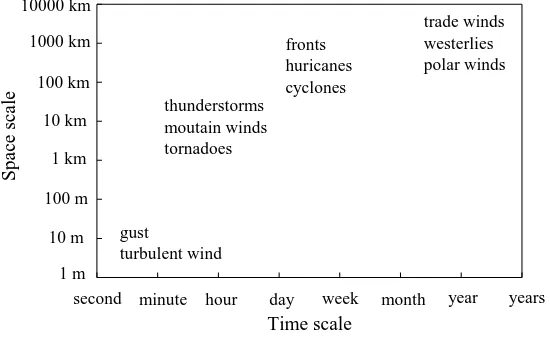
![Fig. 2. DeepCwind floating wind turbine system design [24].](https://thumb-us.123doks.com/thumbv2/123dok_us/1393268.92452/4.595.135.457.530.705/fig-deepcwind-floating-wind-turbine-system-design.webp)
